|
Trooper Sydney Moore - Night
Attack
Operation Totalize 7th August 1944
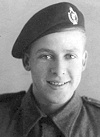
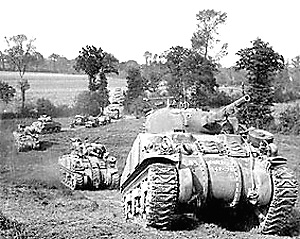
7th AUGUST 1944 – Operation Totalize
The 150 vehicles of the 144th Regiment Royal Armoured Corps spent most of the day inside what remained of the Cormelles Factory to the south east of Caen. It was a perfect evening, warm and still. The tank crews stood by their vehicles while the long summer twilight gradually turned to dusk. Some smoked. Few talked. At 10.45pm as the light was beginning to fail the word was passed down the line; “get mounted” still using the old Calvary command. Five minutes later the silence was shattered by the roar of tank engines starting up
.
The tanks started to move slowly to the ‘Start line’ which was about a mile ahead. There was no problem in finding the right way as the military police had installed a double line of green and amber directional lights. Speeds were kept slow as not to produce too much dust that would alert the Germans of what was going on. The air bombardment was going on during this time so it hid the noise of the tank engines. Every tank crew trooper had been issued with ear plugs for protection from the noise of the bombing and artillery bombardment that was about to start. They were quite unnecessary as nothing could be heard above the noise of the tank engines.
The plan was for a solid phalanx of four tanks a breast with about two yards between each vehicle. The 7th Argyll and Sunderland Highlanders were in armoured troop carriers.
They were 'unfrocked' Priests. A Priest was the name given to a self propelled
gun. The engineers had taken out the artillery gun which left a space for
infantry troops to stand in. There was no wheeled vehicles in the column. It was all tracked and armoured. The task given to the 144th R.A.C was to see the 7th Argylls through to their objective at Cramesnil. There they were to dismount from their armoured vehicles and capture the village by night attack. The tanks were to support the infantry in the normal manner and then help them repel the expected German armoured counter attack the following day. During the advance the tanks were expected to deal with any opposition directly in their path, but were to by-pass places like Tilly, leaving them to be dealt with by other troops following on. The armoured columns were to follow behind an artillery barrage and heavy bombers of Bomber Command were to bomb targets on the flanks just before ‘H’ hour where it was thought German Tank divisions lurked like the big woods east of the village of Secqueville La Campagne.
The drawing below is of an American built M7 "Unfrocked" Priest. It had a range
of 125 miles and had a speed of 25mph. Its maximum protective armour ranged from
12mm to 62mm.
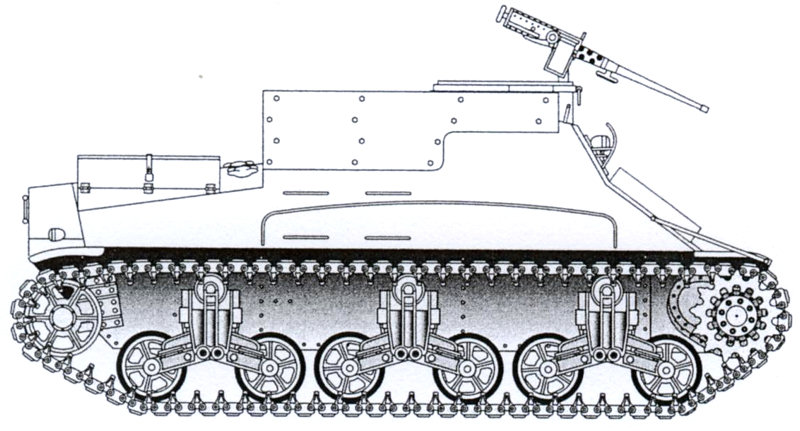
M7 'Unfrocked' Priest Armourded Troop Carrier used in Operation
Totalize August 1944
Trooper Sid Moore and the rest of the Tank crews of 144th Royal Tank Corps waited in the assembly area on the east side of the Route National 158 just north west of the small village of Bras. A mile south of the Cormelles factory. This is where they waited until ‘H’ hour. The forming-up place was in dead ground where the enemy could not see the build up. There was a flat crest a short way to the south and about a mile beyond was Tilly-la- Campagne, firmly held by the enemy (this was going to be detoured around not attacked during the advance). Another two miles further was beyond the village of Cramesnil was the high ground which was that nights final objective. The country was ideal for tracked vehicles, open and gently undulating.
At 11.30pm ‘H’ hour the column of tanks belonging to the 144th RAC crossed the Bras road which marked their start line. The artillery barrage landed just north of Tilly-la Campage and preceded the attack. The advance was lead by Sherman anti-mine Flail tanks and moved forward at the snail’s pace of 1 1/2 miles an hour behind the wall of exploding shells. The engineers reported no mines. After the battle they discovered that the advancing column had missed a minefield by six feet on one side and 12 feet on the other. The air was thick with dust and smoke from the bombardment and use of flail tanks that chewed up the dry hard ground.
The British column got off to a shaky start when the lead navigator’s Stuart tank drove into a large bomb crater about 10 feet deep and could not get out. No sooner had this happen then the two tanks carrying the alternative navigators drove into another crater whist trying to avoid the first. Things went from bad to worse quickly. The dust was so thick it was impossible to see more than a few feet in any direction. The drivers could not see the rear lights of the tank in front. Tanks got lost. It was utter chaos. The navigation systems they had in place did not work. Tank commanders resorted to asking each other who they were and what unit they belonged to.
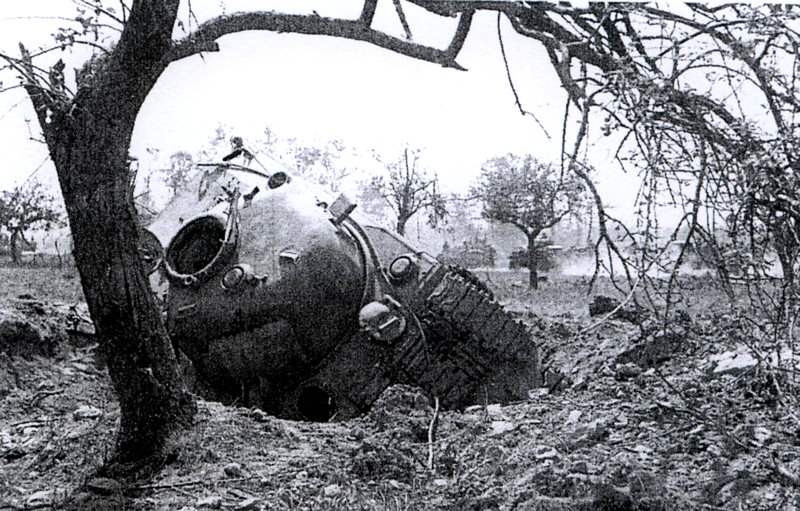
A M4 Sherman Tank stuck in a bomb or artillery shell crater
-They were hard to see at night.
A number of Sherman tanks and three Priests, self propelled artillery guns, were lost to enemy action during the move in fire fights with German infantry equipped with anti-tank weapons in isolated pockets of resistance. The column did bump in to some German Panzers. As one Sherman crossed through a gap in the hedge there was a blinding green flash 50 yards to the left. A German tank shell hit the British tank that was following it. The lead tank managed to swing its turret around to the left and fire two rounds in the general direction of a dark shape the appeared to be a German tank. They hit and set it on fire. Another German tank was detected in the front and destroyed but a third Panzer fired and destroyed another Sherman tank before retreating into the darkness.
How long the confused mass of lost vehicles continued milling around at night in the fog between the road and the railway line is difficult to say. Major Reid in his tank reported that he had found the landmark that they were all looking for. A hut on the Railway line where they were supposed to cross. He sent up a verey light to show the way. Before long tanks started to arrive at that location.
Lieutenant Commander Colonel Alan Jolly, commanding officer of the 144 RAC was concerned about the crossing of the railway line that crossed his axis diagonally, his foreboding was not misplaced. As the lead Sherman tanks reached the railway and attempted to cross it they were fired at by German infantry armed with anti-tank Panzerfaust. In the fire fight a building was destroyed, two tanks including a tiger tank killing Sherman Firefly were lost and several German’s killed and wounded.
(On
the map below Sid's tank was part of the first armoured column,
the first of the big black arrows, just right of the road called
the Route National No. 158, heading south from Caen. You can see
where the railway line that was such a dangerous obstacle,
crossed their route. Sid's tank was hit just about where the tip
of the black arrow is on the map, north of the village of
Cramesnil)
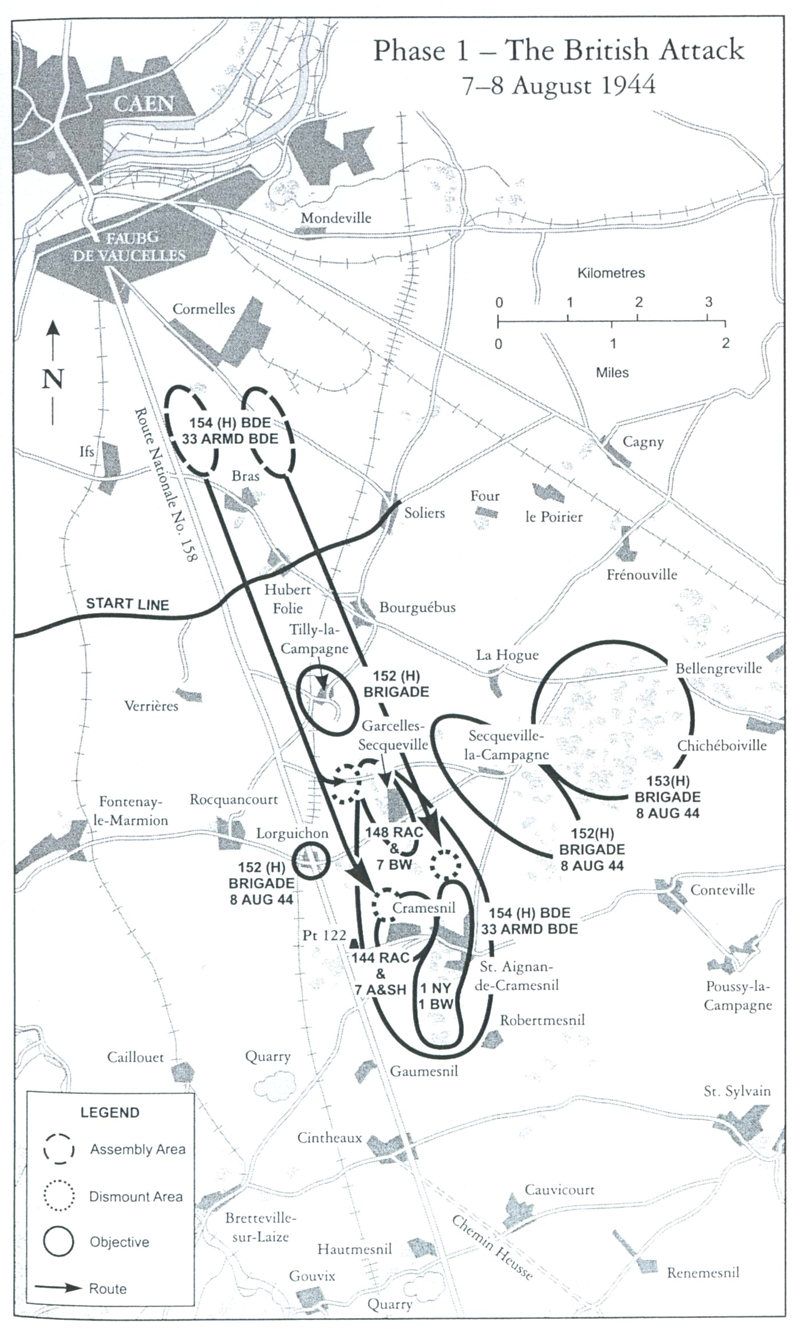
Books that cover
Op Totalize are 'Blue Flash' written by Alan Jolly (p47 covers
Sid) & 'No
Holding Back' by Brian A Reid
|

